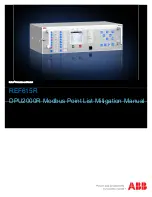
INS_RLXE4GE24MODMS_REV– 20 Dec 2017 PAGE 137
INSTALLATION AND OPERATION MANUAL
RLXE4GE24MODMS
TECH SUPPORT: 1.888.678.9427
NAS(802.1x)
This page allows you to configure the IEEE 802.1X and MAC-based authentication system and port
settings.
The IEEE 802.1X standard defines a port-based access control procedure that prevents
unauthorized access to a network by requiring users to first submit credentials for authentication.
One or more central servers, the backend servers, determine whether the user is allowed
access to the network. These backend (RADIUS) servers are configured on the Authentication
configuration page.
MAC-based authentication allows for authentication of more than one user on the same port,
and doesn’t require the user to have special 802.1X software installed on his system. The switch
uses the user’s MAC address to authenticate against the backend server. Intruders can create
counterfeit MAC addresses, which makes MAC-based authentication less secure than 802.1X
authentication.
Overview of 802.1X (Port-Based) Authentication
In the 802.1X-world, the user is called the supplicant, the switch is the authenticator, and the
RADIUS server is the authentication server. The switch acts as the man-in-the-middle, forwarding
requests and responses between the supplicant and the authentication server. Frames sent
between the supplicant and the switch are special 802.1X frames, known as EAPOL (EAP Over
LANs) frames. EAPOL frames encapsulate EAP PDUs (RFC3748). Frames sent between the switch
and the RADIUS server are RADIUS packets. RADIUS packets also encapsulate EAP PDUs together
with other attributes like the switch’s IP address, name, and the supplicant’s port number on
the switch. EAP is very flexible, in that it allows for different authentication methods, like MD5-
Challenge, PEAP, and TLS. The important thing is that the authenticator (the switch) doesn’t need
to know which authentication method the supplicant and the authentication server are using, or
how many information exchange frames are needed for a particular method. The switch simply
encapsulates the EAP part of the frame into the relevant type (EAPOL or RADIUS) and forwards it.
When authentication is complete, the RADIUS server sends a special packet containing a success
or failure indication. Besides forwarding this decision to the supplicant, the switch uses it to open
up or block traffic on the switch port connected to the supplicant.
Note: Suppose two backend servers are enabled and that the server timeout is configured to X
seconds (using the Authentication configuration page), and suppose that the first server in the
















































